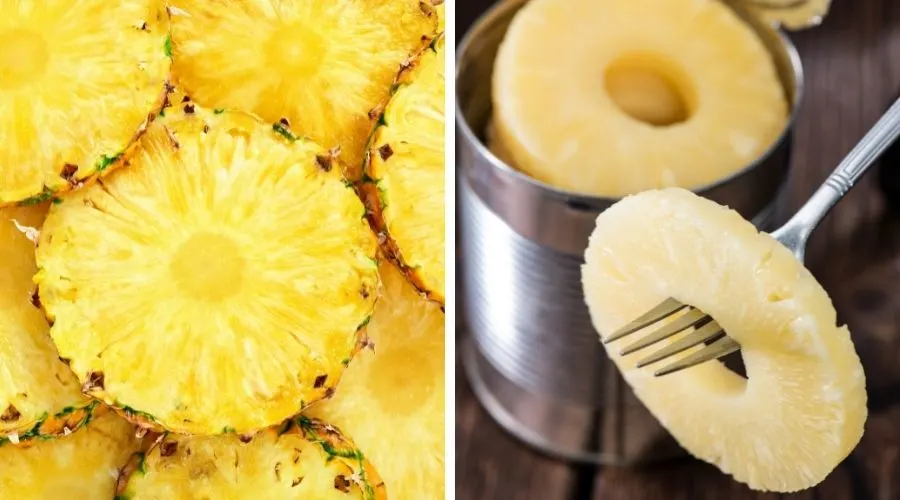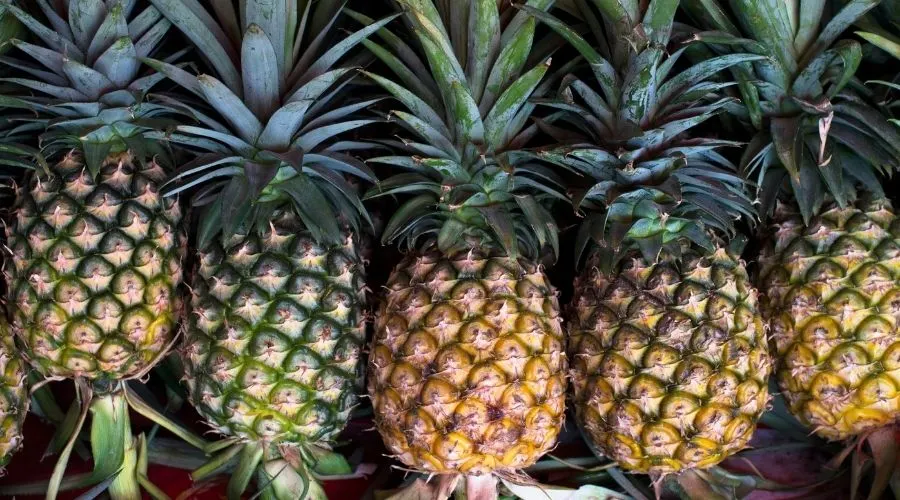Canned pineapple has been a pantry staple for decades, it’s quick, easy, and delicious, for times when peeling and chopping a fresh pineapple feels like too much hard work.
But should we be taking the time to prepare fresh pineapple, and is it the healthier option than the canned alternative?
In this article, I’ll be comparing fresh (or raw) pineapple against the canned alternative head-to-head to find out which is best for nutrition, cost, and flavor, as well as looking at the differences between the two for usage and storage.
Also in This Article
In a hurry, or looking for something specific? Use the links below to jump to the relevant section:
Ingredients Comparision
Obviously, fresh pineapple contains only pineapple, but let’s take a look at the difference when it comes to the canned version.
Canned pineapple contains pineapple, which has been either sliced, cut into chunks, or crushed and then canned with liquid which is either pineapple juice (made with pineapple and water) or syrup (made from water and sugar).
The healthier version of canned pineapple is the kind that’s canned in fruit juice rather than pineapple canned in syrup which contains added sugar. Sugar is naturally occurring in pineapple, so the fruit alone is relatively high in sugar, to begin with.
Some canned pineapple also has citric in the ingredients, which helps to keep the contents fresher for longer (you can read more about citric acid in this WebMD article)

Fresh Pineapple Vs. Canned Nutritional Comparison
Moving onto the nutritional comparison and to keep things fair, this will be done on a weigh-for-weight basis (per 100g).
I’ll be comparing raw pineapple against a generic pineapple canned in juice and drained, using official nutritional data from USDA (see source links at the end of this article).
Please note, if you’re using pineapple canned in light or heavy syrup, then the figures may be different due to the sugar content.
Best for Calorie Content
It could be easy to assume that fresh and canned pineapple contain the same calories, especially when it’s drained; however, the natural juice contains more sugars that are absorbed into the pineapple, and some remain even when drained.
Per 100g of pineapple, there are ten more calories in pineapple, which is canned in juice (and drained) compared to fresh (or raw) pineapple.
| Pineapple Type | Calories Per 100g |
| Fresh/Raw Pineapple | 50kcal |
| Canned Pineapple (in juice) | 60kcal |
Best for Carbohydrate & Sugar Content
When it comes to carbohydrates and sugar, fresh and canned pineapple is relatively high in both compared to some other fruits such as berries.
Pineapple that is canned in juice is higher in both carbs and sugar than fresh pineapple, with 2.5g more carbs and 4.45g more sugar per 100g.
| Pineapple Type | Carbohydrates Per 100g | Of Which Are Sugars |
| Fresh/Raw Pineapple | 13.1g | 9.85g |
| Canned Pineapple (in juice) | 15.6g | 14.3g |
More Nutrition Categories
Fresh and canned pineapple naturally contain small amounts of protein, fat, dietary Fiber and sodium, amounts are very similar for each category and the difference between the two kinds of pineapple are nominal.
| Nutrition Type | Fresh/Raw Pineapple | Canned Pineapple (In Juice) |
| Protein | 0.54g | 0.51g |
| Fat | 0.12g | 0.11g |
| Dietary Fiber | 1.4g | 1.3g |
| Sodium | 1mg | 1mg |
Best for Vitamins/Minerals
Both fresh and canned pineapple contain a range of naturally occurring vitamins and minerals, with some being at a similar level.
Fresh pineapple is higher in more kinds of vitamins and minerals, especially when it comes to vitamin C, which is much higher in fresh pineapple compared to canned.
| Vitamin/Mineral Type | Amount Per Serving of Fresh Pineapple | Amount Per Serving of Canned Pineapple |
| Calcium | 13mg | 16mg |
| Iron | 0.29mg | 0.28mg |
| Phosphorus | 8mg | 7mg |
| Potassium | 109mg | 124mg |
| Magnesium | 12mg | 15mg |
| Vitamin B6 | 0.112mg | 0.075mg |
| Vitamin C | 47.8mg | 9.4mg |
| Vitamin A | 3mcg | 3mcg |
| Niacin | 0.5mg | 0.28mg |
*mcg = microgram (1000th of a milligram) / mg = milligram (1000th of a gram)

Best for Flavor/Texture
Fresh pineapple and pineapple canned in juice, does taste a little different and has a slightly different texture due to the fact canned pineapple is soaked in juice.
To decide which is best for taste, I need to get a wider opinion via a poll from a wide selection of readers.
You can help our future readers and us by voting in the poll below to tell us which you prefer and once you vote, the winner so far will be revealed.
Best For Storage
Depending on how fresh a pineapple is when you buy it and the temperature its stored at, a fresh pineapple should last a week or even two. The longer it’s kept the riper and sweeter it will become, but once they start to spoil, they deteriorate daily quickly.
Compared to canned pineapple which if kept sealed in a cool dark place will last for around 18-24 months.
So when it comes to storage, if you want to pineapple for a long time, it probably comes as no surprise that canned pineapple is the best option which is there whenever you need it.
Usage
Pineapple is generally eaten as it is but it also works well in smoothes, juices, salads, fruit salads and even baking.
In most situations, either fresh or canned pineapple will work well, but canned pineapple tends to be more watery as it’s stored in juice so it may not work as well in baking.
Fresh pineapple is also the better option when it comes to juices and smoothies and you get the benefit of more Vitamin C than you would get with the canned version.
This makes fresh pineapple the winner of the two when it comes to uses, but canned pineapple is a great substitute which you can keep in the pantry on a long-term basis.
Best for Price
An average-sized whole pineapple weighs around 900-1100g/31.7-38.8oz (including the crown) and once the crown, core and skin is removed the edible weight of pineapple is around 450-550g/15.9-19.4oz per pineapple.
At the time of writing this article, an average fresh pineapple costs around $1.99 (USA Price), and based on the average weights above, this is equal to 10-13¢ per ounce of edible fresh pineapple.
Compared to pineapple canned in juice, which costs an average of 6-10¢ per ounce depending on the brand.
Based on this information, weight-for-weight, canned pinapple is cheaper than fresh pineapple.
Overall Winner
All categories have now been compared and the winner of the contest between fresh pineapple and canned is fresh pineapple!
Fresh pineapple beats the canned version because it has less calories, it’s lower in carbs and sugar and higher in vitamins and minerals, especially vitamin C.
Canned pineapple is still a great alternative which is better than fresh pineapple when it comes to storage and cost.
Ulimatley, each one has it’s own uses and it all comes down to which you like best, but when it comes to nutrition, you can’t beat fresh!
| Comparison Category | Winner (Fresh Pineapple or Canned Pineapple) |
| Best for Calorie Content | Fresh Pineapple |
| Best for Carbohydrate Content | Fresh Pineapple |
| Best for Sugar Content | Fresh Pineapple |
| Best for Vitamins/Minerals | Fresh Pineapple |
| Best for Storage | Canned Pineapple |
| Best for Price | Canned Pineapple |
| Overall Winner | Fresh Pineapple |
Related Articles
I hope this article has helped you to find the information you were looking for; you might also find the following articles helpful too:
Canned Corn Vs. Frozen (Which is Best?)
Cheerios vs Grape Nuts (Which One Should You Get)
References Used for this Article
To ensure the nutritional information used in this article is accurate, I have used data from USDA FoodData Central; the links below contain the source information:
